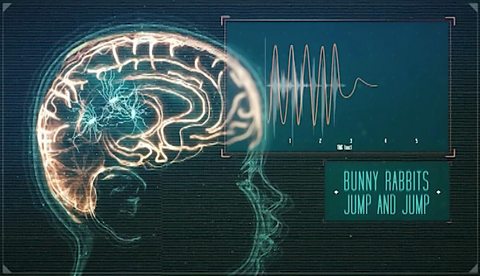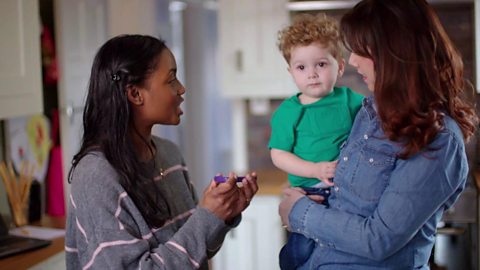Lots of people automatically speak to babies with a 'baby voice', using a sing-song rhythm and silly sounding words like 'bunny' and 'doggy'. But how does this affect the way babies learn language?
Researchers at the University of Cambridge are investigating the effects of âbaby talkâ on babies' brains. Theyâve found that the rhythm we use when we speak to babies is important to language learning, and that baby talk emphasises a rhythm that really helps children to learn words quickly.
We caught up with Professor Usha Goswami, who is leading on the project, to find out more.
Guddi:
Scientists now think we may be able to improve babies' language just by the way we talk to them.
Mum:
I can see you.
Guddi:
Good communication skills accelerate children's ability to think and learn for themselves.
Hello. Hi!
Here at Cambridge University, Professor Usha Goswami has set up an experiment to find out the best way to talk to a baby.
Usha:
I'm going to set up the experiment.
Mum:
I can see you. I can see you. IâŠcanâŠseeâŠyou.
Guddi:
The team are using this set up to find out what's happening inside babies' brains when they listen to Parentese.
Mum:
I can see you.
Guddi:
That special way of speaking that we all automatically seem to use whenever we talk to babies.
Mum:
I can see you.
Guddi:
Parentese is a way of speaking that heightens pitch, exaggerates the length of words and is very rhythmic.
Mum:
Bunny rabbits jump and jump.
Guddi:
Now Elsie is taking part in the experiment.
Mum:
Like to show me your toy?
Guddi:
She listens carefully to the Parentese.
Mum:
Where's the bear? Can you see him?
Guddi:
But when it comes to the normal speechâŠ
Mum:
Hickory dickory dock. The mouse ran up the clock.
Guddi:
She quickly loses interest. This pattern of behaviour is backed up by other studies that show babies prefer to listen to Parentese.
Mum:
I can see you. I can see you.
Guddi:
But what's happening inside their brains?
Mum:
Bunny rabbits jump and jump.
Usha:
Baby's brain electrical signalling is pulsing, basically, in time with those big rhythm patterns.
Mum:
I can see you.
Guddi:
This brain synchronisation is represented in this simulation.
Mum:
Bunny rabbits jump and jump.
Guddi:
Usha and her team are the first in the world to show that Parentese contains these large rhythmic modulations and that this mattersfor babies' developing brains.
Mum:
Happy babies clap and clap.
Mum 2:Hi Sophie!
Guddi:
It seems natural that we would use Parentese, that we all seem to do it without even thinking about it. But there are lots of debates about whether that's even the best way to do that.
Usha:
I think the evidence is really firmly in favour of the fact that you should talk to your baby as much as you can using Parentese.
Mum:
I can see you. I can see you.
Mum 2:
I know that Elsie responds better to me when I speak to her in baby speak. But to see that the science is proving that is amazing.
Why is the rhythm of baby talk good for babies?

âIn the Baby Rhythm Project, we've been following 120 infants over the first 2 and a half years of their life to see how important rhythm is in the development of language,â says Usha. Theyâve been testing how babiesâ brains respond to âbaby talkâ with itâs sing-song rhythm versus normal speech.
Our data suggest that rhythm is fundamental to language learning - both being spoken to in baby talk, which has exaggerated rhythm structures, and a lot of the interactions we do with babies, like bouncing them on the knee or singing. All of those kinds of rhythm seem to be important for how babies learn language.
We tend towards the same rhythm when we speak in baby talk, she says. âWe've looked at the way in which mums talk to babies in different languages and unconsciously they're exaggerating a rhythm pattern of around 120 beats a minute.â This is perfect for babies to learn from it seems. Her teamâs experiments have shown that babiesâ brainwaves seem to work in sync with this rhythm of speech. âWe measured the brain response from 2 months, and it was always strongest to speech at that rhythm.â
Usha explains further. âBasically, the brain works by rhythm. You've got brain cells in large networks that are signalling using these pulses of electricity. You could think of this like fireflies in the forest. Each firefly is flickering on and off with a little pulse of electricity, but it's all random. But if you imagine someone in that forest playing a drum and all of the fireflies deciding to go on and off in time with that drumbeat, that's what your brain does [when it hears the rhythm of speech].â
It just so happens that the most common rhythm in human speech is the one we emphasise when we speak to babies. âHuman speech is the most complex sound signal the brain receives, and there are many different rhythms to it, but the dominant rhythm is this 120 beats per minute that we exaggerate in baby talk. So this seems a great place for babyâs brains to start. We do it unconsciously, but it seems to be very important for the learning brain.â

Are words like âdoggyâ and âbunnyâ good for babies too?

When we speak to babies, we tend to use lots of versions of words that arenât quite correct English, things like âdoggyâ, âbunnyâ and âmummyâ. It might seem odd, but Usha says that these are helpful for children learning to speak compared to using the âproperâ words. This is because they make the rhythm pattern of speech really obvious and clear. âWhen we speak, we usually alternate between strong and weak syllables. Our voices go up and down in loudness. In baby speak, we naturally emphasise that rhythm more than ever: âDad-dyâ, âmum-myâ, âba-byâ.â
Usha says that these words are much easier for babies to pick out and recognise when adults speak to them âWhen adults speak, our language is often a constant stream, there are no gaps when we're talking so you have to learn where to cut word from word. A good way to do this is to tune into that strong/weak pattern, which is so clear in words like âDaddyâ, âMummyâ, âdoggyâ, âkitty,ââ she says. When babies are able to clearly pick words out in this way, theyâre more likely to remember them.
This is another thing we do unconsciously when talking to babies, but which really aids their language learning.
When we make the sound patterns fit that template of âstrong/weak/strong/weakâ, then weâve taken away one level of difficulty in learning a language.

How do nursery rhymes help?

Not only do we speak to babies in an exaggerated way, but adults often sing songs to babies from birth, particularly nursery rhymes. Usha is clear on the benefits of this. âI think nursery rhymes are fundamentally important because they present perfect rhythm structures. When adults speak to one another, we're not being rhythmically regular. But when you're singing to somebody, you're timing your language to an external beat, which helps children to predict the rhythm. In a nursery rhyme, which has a very simple rhythm pattern, babies get this especially good framework for learning about language.â
Usha says that the tradition of singing to babies and exaggerating rhythm patterns in our speech dates back to early human life and has evolved over time to the way we speak to babies today in a way that boosts their brainsâ abilities to learn language. Food for thought the next time you sing âWheels On The Busâ or ask your baby what the âdoggyâ is doing.
- Want to know more about baby talk? Check out how we put it to the test in our Speech Lab film
- Check out more on the benefits of nursery rhymes







